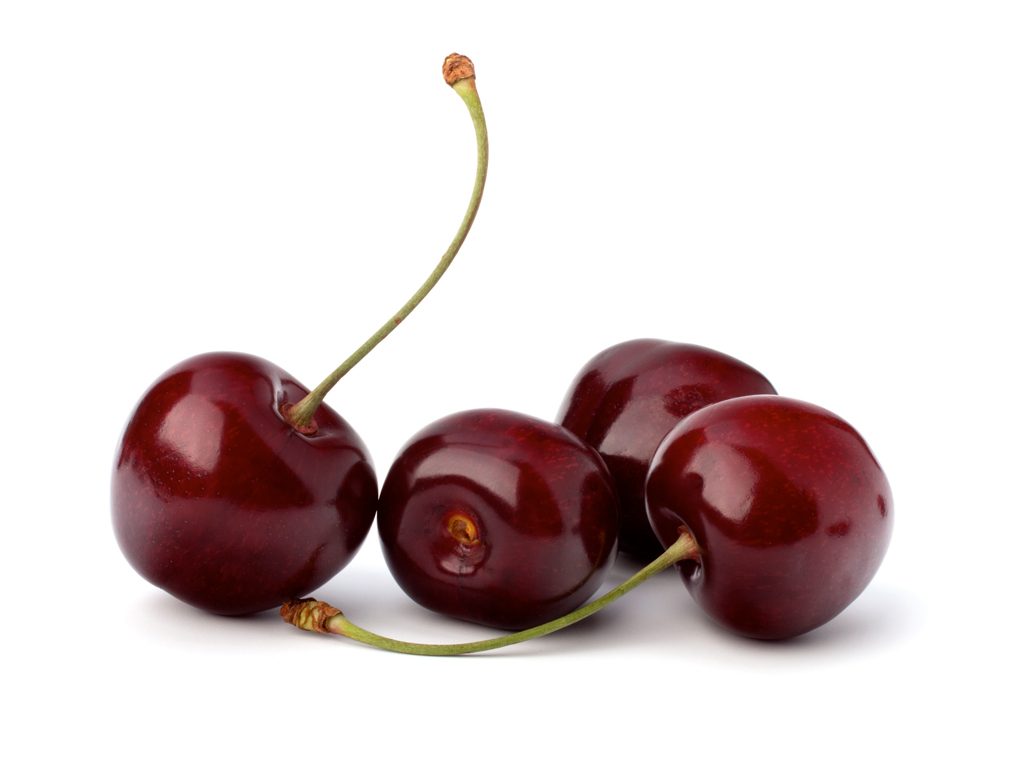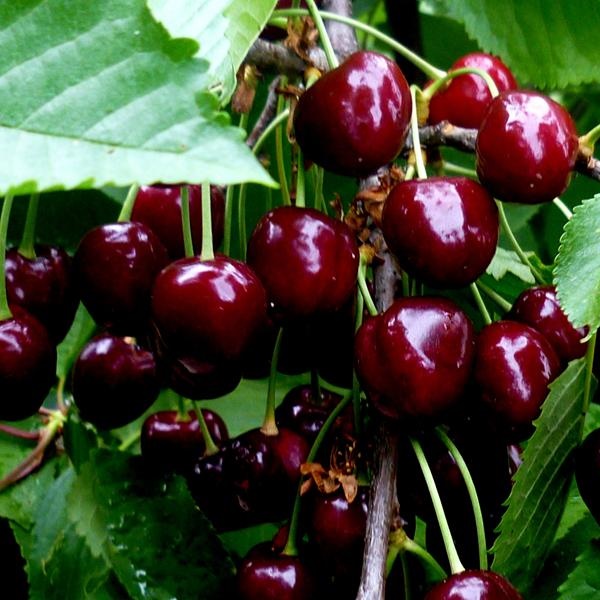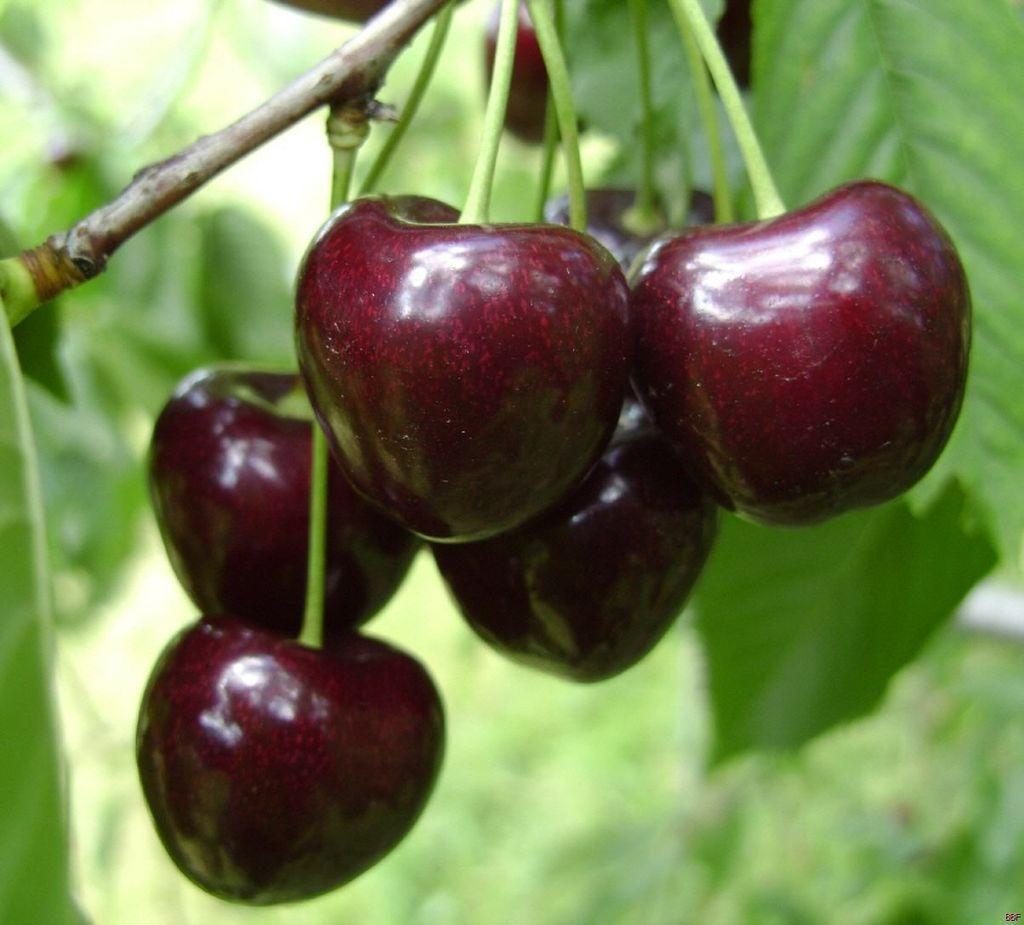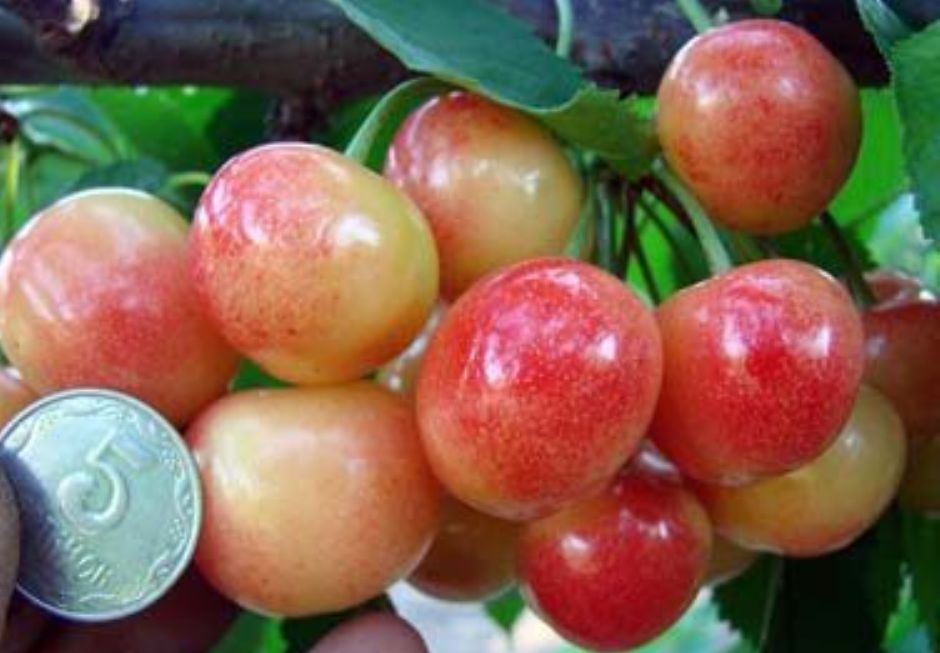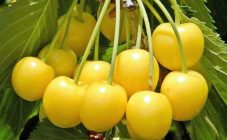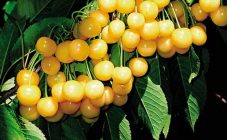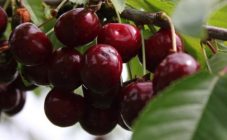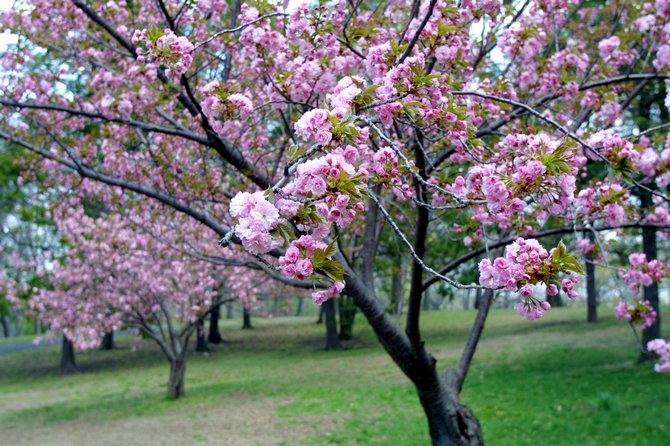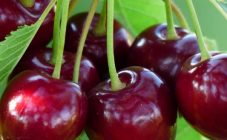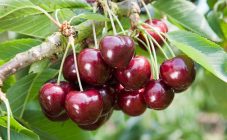Content:
Sweet cherry is a woody, unpretentious fruiting plant belonging to the Plum genus. It has dark green foliage and juicy sweet fruits. The lifespan of one tree can be up to 100 years. The root system is horizontal, but the older the cherry tree is, the deeper the roots go into the ground. Young seedlings begin to bear fruit at the age of 4-7 years. The height of an adult sweet cherry can reach 25 m, young trees - 12-15 m. Basically, this tree is thermophilic, but the breeders managed to breed varieties for central Russia.
Where does sweet cherry grow
Where there is a lot of light and heat and little rainfall - in the territory of southern Europe, Crimea, Turkey, Iran and Asia. Wet and sandy ground is not suitable for this tree. The ideal place for cherries is loose, dry soil. Where does sweet cherry grow in Russia? In the middle lane and southern part of the country.
Many argue: is a cherry a berry or a fruit? From the point of view of botany, sweet cherry is a fruit that is divided into three types: fleshy, stone fruit, dry. Sweet cherry is a stone fruit, from which we can conclude that sweet cherry is a fruit. However, in cooking and in everyday life, cherries are considered a berry. So discussions on the topic "Is a cherry a berry or a fruit?" will always exist.
The cultivation of sweet cherries took place a long time ago, approximately in the 10th-11th centuries, before that time people were picking berries from wild trees. Cherry appeared in Russia thanks to Yuri Dolgoruky and his son Andrei Bogolyubsky, who began to plant large orchards in the 11th century. in Moscow. The first cherry bush was brought from Suzdal.
Since ancient times, cherries have been used not only for food, but also for the treatment of various diseases - gout, kidney, bladder, and indigestion.
The chemical composition of cherries and useful properties
Cherry consists of organic and pectin substances, sugar (fructose and glucose), micro and macro elements. In addition to proteins, fats, carbohydrates, cherries contain fiber, potassium, copper, magnesium, phosphorus, iron, as well as a group of vitamins: C, B5 and B6, A, B1 and B2, K. Sweet cherries are rich in folic acid, tannins, flavonoids.
This seasonal fruit has a low calorie content - about 60 Kcal per 100 g of product.
Many people are interested in how much sugar is in a cherry? Despite all the usefulness, there is a lot of sugar in it - 11.5 g per 100 g of product.
Regular consumption of cherries has a positive effect on the body and improves health:
- On the part of the cardiovascular system, it lowers blood pressure and cholesterol levels, strengthens the walls of blood vessels, prevents blood clots and is the prevention of anemia.
- On the part of the digestive system, it normalizes the state of gastritis and duodenal ulcer, eliminates persistent constipation, improves digestion and metabolism.
- On the part of the endocrine system, it improves the condition in mild forms of diabetes mellitus, normalizes the general well-being in diseases of the endocrine system and the adrenal glands, normalizes the general hormonal background.
- The liver and kidneys cleanses of toxins, radionuclides, nitrogenous toxins, helps the urinary system, and removes uric acid.
- It improves the condition of rheumatism, gout and arthritis, reduces the level of C-reactive protein, dissolves salts, and prevents inflammation of the joints.
- Improves the appearance of acne skin, reduces the number of blackheads, acne, freckles, tightens pores. Trace elements in the composition of the fruit help the tan to gain a foothold and look better.
- For the prevention of malignant tumors, antioxidants remove free radicals, thereby preventing the risk of cancer. Cyanidin and quercetin resist genetic mutations, preventing cancer cells from growing uncontrollably.
- Anthocyanins, hydroxycinnamic acid protect neurons in the brain by stopping oxidative processes. Diseases of the brain are calmer.
What are the benefits of cherries during pregnancy:
- For the expectant mother in the early stages, it helps to overcome the feeling of nausea, does not contribute to weight gain, strengthens the immune system, and helps the body with stressful loads.
- For the unborn baby, it has a positive effect on the development of the placenta and during the formation of organs, enriches the small body with potassium and calcium.
Contraindications
In some cases, eating berries can be harmful. The berry is categorically contraindicated for people with diseases such as intestinal adhesions, increased flatulence. If there is inflammation in the lungs, eating cherries should be postponed until recovery.
In severe forms of diabetes, when bread units and the glycemic index are constantly calculated, the use of cherries in the form of jam, compotes is prohibited. GI of fresh cherries - 25 units. But only fresh, it has such a low index. Heat treatment increases the GI.
Of course, small children under one or a half years old should not be allowed to taste the fruits. These berries can cause food allergies in young children if they are eaten too much.
Older children can eat cherries, but heredity and a history of allergies should be taken into account. If your child has a reaction to red fruits and vegetables, cherries are likely to cause allergies too.
How to use cherries
In addition to the simple use of fresh berries, cherries are added to various desserts, baked goods, jam and jams are made, frozen and dried for the winter, liqueurs, fruit salads, mashed potatoes and juices are made.
As means of traditional medicine, cherries are used both internally and externally. Cherry pulp is used as an antipyretic, as it contains salicylates.
Even the stalks, that is, the small branches with which the berries hang on the branch, are not thrown away just like that. A decoction of the stalks is used as a diuretic and fixative.
For cosmetic purposes, berry extract is used, which is then added to shampoos and medicated hair oils.
Compotes, infusions of fresh and dried berries are used as a tonic, diuretic and expectorant for kidney stones and worms.
If you have trouble sleeping, a glass of smoothie or freshly squeezed cherry juice at night will help you fall asleep. Thanks to the berries, melatonin, the sleep hormone, is actively produced.
Nutritionists know what cherries are rich in and advise those who want to lose weight to consume these dark red berries more often. The composition of KBZhU cherries allows the body to quickly get full, accelerate metabolism and not gain extra calories. Anthocyanins prevent fat from being stored in reserve.
Some are sure that cherry gruel relieves headaches if mashed ripe berries are put on the forehead. But for the face, such a natural mask will definitely benefit. You can use only crushed cherries, or you can add a little honey or a drop of peach cosmetic oil for the face, the effect will be amazing - the skin is cleansed and moisturized.
But not only cherries are used for medicinal and cosmetic purposes. Crushed cherry flowers and leaves are applied to small wounds, abscesses and boils, the medicinal properties of cherries help to draw out pus.
Cherry seed juice is often added to eau de parfum. Ointments are also made from them.
Characteristics of species and varieties of crops
All cherries can be divided into three varieties: early, medium, late.
Early ripening varieties, in turn, are divided into several groups:
- Backyard. Self-pollinating. Yellow, sweet and sour berries. Good harvest. Resistant to frost.
- Ovstuzhenka. Self-pollinating partially. It is planted together with the Iput variety. Frost resistant. The fruits are large and tasty.
- Gronkovaya. We need pollinators - Ovstuzhenka, Raditsa, Iput, Fatezh, Cheremashnaya. The berries are dark red, juicy, and have a pleasant taste.
- Red hill. Pollinators are required - Revna, Bryansk pink, Raditsa, Tyutchevka, Ovstuzhenka. Not very disease resistant. The taste is honeyed, sugary. The color of the berries is scarlet with golden highlights.
- Iput. Pollinated using the same varieties as Krasnaya Gorka. Does not tolerate cold weather. Dark red, almost black color of berries. The pulp is deep red. The taste is sweet, aromatic.
Medium-ripening varieties are mainly planted in pairs for pollination. There will be no harvest without pollination. Most recommended pairs:
- In memory of Chernyshevsky + Adeline. The Adelina variety has large fruits with high palatability. The trees are frost-resistant. Variety Memory Chernyshevsky has fruits from red to dark red. High frost resistance.
- Tyutchevka + Raditsa. The Tyutchevka variety is highly resistant to cold. The berries are dark red, sweet. A good option for the middle lane. The Raditsa variety has large, juicy berries with a sweet taste. Sensitive to frost.
There are quite a few varieties of late ripening. The best ones are:
- Bryanochka. Dark red, sweet berries. Pollinated by such varieties as Iput, Veda, Tyutchevka.
- Michurinskaya late. Berries of medium size, very juicy and sweet. The varieties Pink Pearl and Michurinka are pollinators.
- Exhibition. Large reddish fruit with a pleasant taste. Winter hardy. Pollinators: Recordist, Market, Early Cassina.
- Napoleon. Dark, large, sour berries. Can be pollinated on its own.
- Regina. Large dark red color, rich berry flavor. Withstand frosts down to -25 ° С. Pollinated by Karina, Coral, Nephris, Sylvia.
- Francis. The berries are large, creamy beige in color, with a delicate taste. Suitable pollinators: Bigarro, Early Cassina, Black Daibera, Denissena, Gedelfingen.
Features of planting and crop care
The best periods for planting seedlings are spring and autumn. In the spring, the bushes are planted before the buds begin to bloom. In the fall, you can plant when all the leaves from the trees fall off, but no later than 2 weeks before frost.
Before planting, the roots are examined, dry roots are removed, and soaked in clay. You need to try to lay the roots in a straightened form. After they are covered with soil, the seat is compacted.
The land around the bush must be clean, free of weeds (within a radius of 1 m).
The culture does not need frequent watering, it will be enough to water abundantly 3-4 times per season (in May, June and October). About 3-4 buckets of water under the bush.
The trees are fed both with complex fertilizers, which are sold in stores, and with manure and ash. Complex additives are diluted according to the instructions, manure and ash are dissolved with water in a ratio of 1: 8 or 1:10. Top dressing should be applied in the spring, before the bush begins to bear fruit.
The first feeding is done after 3 years have passed since the planting of the seedling. Once every 5 years liming is necessary - top dressing with the addition of limestone, chalk, dolomite flour. Fertilization should be divided. It is impossible to use both organic and limestone fertilizers in the same period.
Experienced gardening tips
- Do not plant cherries too close to the fence. Tall buildings and large trees should not cast a shadow on the tree.
- It is not worth planting varieties that are not suitable for the climate.
- Inexperienced gardeners often use nitrogen fertilizers to accelerate growth. Nitrogen stimulates the growth of greenery at the expense of the crop. Therefore, fertilizers containing potassium and phosphorus should be used as top dressing.
- If during the flowering period the bushes are sprayed with water with the addition of honey, pollination will be very effective. The sweet smell will attract bees.
- To attract bees, you can plant honey-bearing flowers near the cherry. These include: thyme, mint, sweet clover, goat's rue, lemon balm, clover, blackhead, angelica, goldenrod, clover, cornflower, copse, lungwort.
Sweet cherry is worthy of cultivation in every summer cottage. It is worth taking a closer look at it because of the beneficial properties that berries have, and unpretentiousness in care. An important fact is the abundance of various varieties, from which each gardener will choose the one he likes in appearance and taste.
